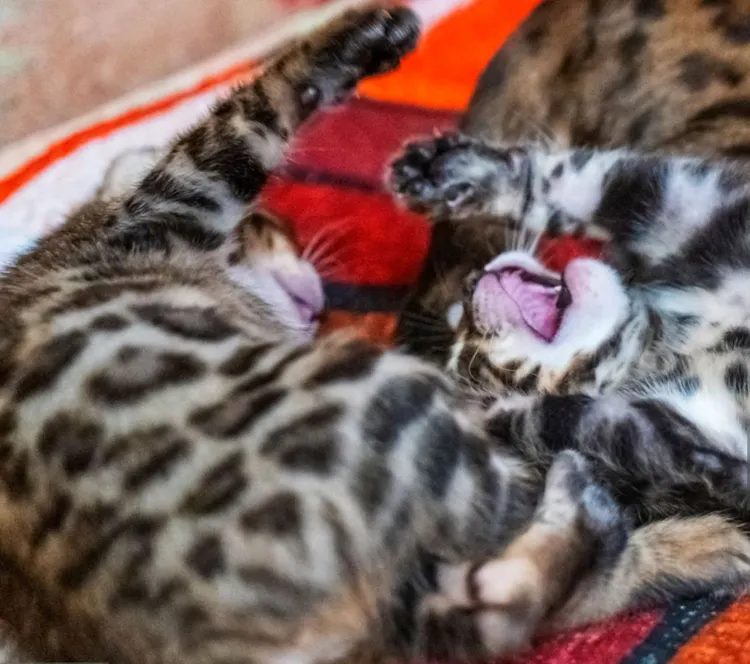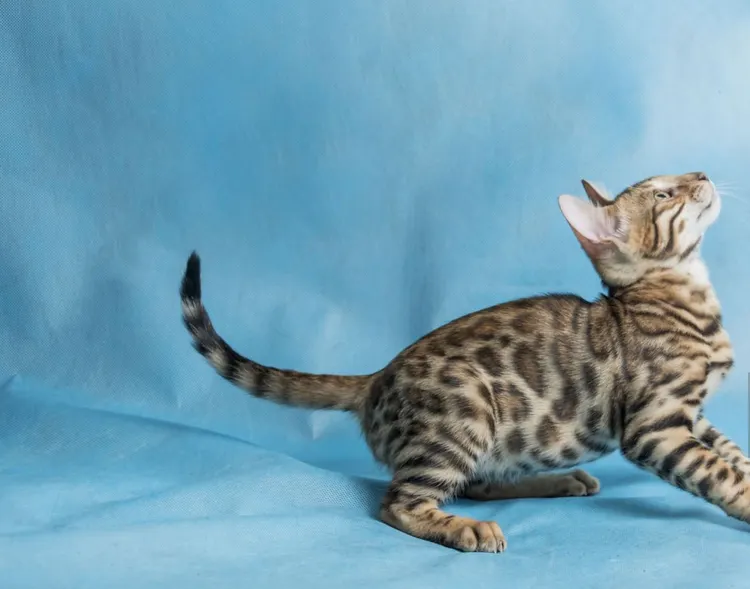Looking for a cat with a striking coat, high energy, and a wild appearance but a loving personality? Look no further than the blue Bengal cat. This captivating breed, with its distinctive blue-gray coat, is a unique addition to any cat lover’s home. Whether you’re already smitten by this feline’s beauty or you’re considering bringing one into your family, there’s much to learn about their characteristics, care needs, and how to keep things eco-friendly.
In this guide, we’ll cover everything from what makes the blue Bengal cat special to how you can adopt and care for one sustainably. Ready to dive in? Let’s explore!
What Is a Blue Bengal Cat? Characteristics That Make Them Stand Out
The Bengal cat is already known for its exotic, wild-like appearance, resembling the majestic leopard. However, the blue Bengal is a rare and stunning variety of this breed, boasting a beautiful blue or silver-toned coat with subtle rosettes or spots.
Physical Characteristics:
Coat: The blue Bengal cat’s coat is an eye-catcher, ranging from a soft silver-blue to steel-gray. This unique coloring is a result of recessive genes, making blue Bengals relatively rare. Their coats often have marbled or spotted patterns, adding to their wild, exotic look.
Size: Blue Bengals are medium to large cats, with males typically weighing between 10-15 pounds, and females slightly smaller at 8-12 pounds. Their athletic build and long, muscular bodies give them a powerful yet graceful appearance.
Eyes: Most blue Bengals have striking eyes that range from gold to green. Their eyes are often one of their most captivating features, enhancing their wild yet elegant appearance.
Personality: These cats are highly intelligent, energetic, and social. They love to interact with their humans, play games, and even learn tricks. Bengals are curious and adventurous, often needing plenty of mental and physical stimulation to stay happy.
Hypoallergenic Qualities:
While not completely hypoallergenic, Bengal cats, including the blue variety, tend to produce fewer allergens than some other breeds. This is thanks to their short, sleek coats that shed less fur and dander. Allergy sufferers may find Bengals easier to live with than other cat breeds.
Practical Tips for Adopting a Blue Bengal Cat
Bringing a blue Bengal cat into your home can be an incredibly rewarding experience. However, these high-energy cats have specific needs. Here’s what you should know if you’re planning to adopt one.

1. Blue Bengals Are Highly Active
If you’re adopting a blue Bengal, prepare for a cat that loves to move. They’re known for their agility and playful behavior. Whether it’s climbing, chasing, or even playing fetch (yes, some Bengals fetch!), these cats thrive in environments that provide ample stimulation.
- Pro tip: Invest in a tall, sturdy cat tree or create vertical spaces for your Bengal to climb and explore. You can also rotate toys frequently to keep them mentally engaged.
- Eco-friendly playtime: Opt for toys made from natural materials like hemp or wool, or recycled fabrics. You can also make your own DIY toys from household items like paper rolls or old socks stuffed with catnip.
2. They’re Highly Social
Blue Bengals don’t like to be left alone for long periods. If you’re out of the house often, this breed might get bored or lonely, which can lead to destructive behavior. Consider adopting a second cat or making sure someone is around to engage with your Bengal.
- Pro tip: Puzzle feeders and interactive toys can keep your Bengal occupied while you’re away. These cats love challenges, so offering them opportunities to “work” for treats is a great way to keep their minds sharp.
3. Grooming Your Blue Bengal
One of the advantages of the Bengal cat’s sleek coat is its low-maintenance grooming needs. Their short, dense fur doesn’t mat easily and requires only occasional brushing.
- Sustainable grooming tip: Use a bamboo brush or a grooming glove made from eco-friendly materials. You can also compost the fur that collects in your brush!
Feeding Your Blue Bengal: A Healthy and Eco-Friendly Diet
Bengal cats are carnivores, and they thrive on a diet rich in protein. It’s essential to feed your Bengal a diet that mimics what they would eat in the wild—think high-protein, grain-free cat food made from quality ingredients. But how can you do this sustainably?

1. Choose Eco-Friendly Brands
Look for cat food brands that prioritize sustainably sourced ingredients and use eco-conscious packaging. Many pet food companies now offer organic, free-range meat options and use recyclable or biodegradable packaging.
- Sustainable feeding tip: Try brands that offer cat food made from alternative proteins like insect-based kibble, which has a lower environmental impact than traditional meat production.
2. Consider a Raw Diet
Some Bengal owners opt to feed their cats a raw diet to more closely mimic their natural eating habits. This involves feeding raw meats and bones, but it’s important to consult with a vet or feline nutritionist to ensure you’re providing a balanced diet.
- Eco-friendly twist: If you go the raw route, consider sourcing meat from local farms or butchers to reduce your carbon footprint and support local businesses.
3. Use Sustainable Feeding Products
Look for stainless steel or ceramic bowls, which are more durable and eco-friendly than plastic alternatives. Bamboo feeding mats are also a great option to keep your feeding area clean without relying on synthetic materials.
Living with a Blue Bengal Cat: Eco-Friendly Tips for a Sustainable Home
Having a pet inevitably increases your household’s environmental footprint, but there are many ways to keep your blue Bengal’s care eco-friendly. Here are a few tips for living sustainably with your new feline friend.
1. Eco-Friendly Litter Options
Traditional clay-based cat litters contribute to environmental damage through strip mining and are not biodegradable. Luckily, there are several greener alternatives:
- Wood-based litter: Biodegradable and compostable, wood-based litters are a great eco-friendly option.
- Recycled paper: Soft, dust-free, and highly absorbent, this type of litter is made from post-consumer products.
- Corn or wheat-based litter: Natural and biodegradable, these litters offer an earth-friendly alternative.
Using eco-friendly litter reduces your impact on the environment and provides a healthier living space for your Bengal.
2. Sustainable Cat Furniture
Blue Bengals are climbers, and they need plenty of places to jump, perch, and explore. Instead of purchasing mass-produced furniture made from unsustainable materials, consider more eco-conscious options.
- Pro tip: Look for cat trees or shelves made from reclaimed wood or sustainable materials like bamboo. Natural sisal or hemp is a great alternative to synthetic scratching posts.
3. Eco-Friendly Cleaning
As a pet owner, cleaning is a part of life. From accidents to shedding, having the right eco-friendly cleaning products on hand is a must.
- Natural cleaning solutions: Instead of using chemical cleaners that are harmful to the environment, opt for natural alternatives like vinegar and baking soda. These are safe for both your Bengal and the planet.
- Reusable cleaning tools: Swap disposable cleaning wipes for reusable cloths and mop pads to cut down on waste.
The Blue Bengal’s Personality: What You Need to Know
So, what’s it really like living with a blue Bengal? If you’re ready for an affectionate, playful, and active cat that thrives on attention, this breed is for you. Bengals are known for their dog-like behaviors, including following their humans around the house and even learning to fetch!
1. High Energy, High Playfulness
Bengals are extremely playful and intelligent. They require mental stimulation, and without it, they can become bored or mischievous. Expect to dedicate time each day to play and interaction with your Bengal.
2. Affectionate but Independent
While Bengals are social and love attention, they also value their independence. They might not be the biggest lap cats, but they will always find ways to be involved in your daily activities—whether that’s following you from room to room or observing from a high perch.
3. Good with Kids and Other Pets
Bengals are generally great with children and other pets, making them a fantastic addition.
Before you get too lost in the world of blue Bengal cats, why not stick around for more fun feline facts? Join our newsletter for a purr-fect blend of tips, tricks, and all things cat-related. We promise, no spam—just pawsome content straight to your inbox!



